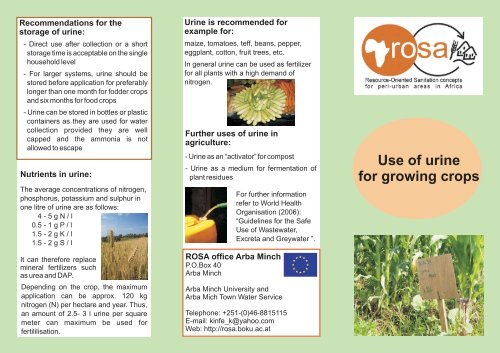Use of urine for growing crops - SuSanA
Use of urine for growing crops - SuSanA
Use of urine for growing crops - SuSanA
Create successful ePaper yourself
Turn your PDF publications into a flip-book with our unique Google optimized e-Paper software.
Recommendations <strong>for</strong> the<br />
storage <strong>of</strong> <strong>urine</strong>:<br />
- Direct use after collection or a short<br />
storage time is acceptable on the single<br />
household level<br />
- For larger systems, <strong>urine</strong> should be<br />
stored be<strong>for</strong>e application <strong>for</strong> preferably<br />
longer than one month <strong>for</strong> fodder <strong>crops</strong><br />
and six months <strong>for</strong> food <strong>crops</strong><br />
- Urine can be stored in bottles or plastic<br />
containers as they are used <strong>for</strong> water<br />
collection provided they are well<br />
capped and the ammonia is not<br />
allowed to escape<br />
Nutrients in <strong>urine</strong>:<br />
The average concentrations <strong>of</strong> nitrogen,<br />
phosphorus, potassium and sulphur in<br />
one litre <strong>of</strong> <strong>urine</strong> are as follows:<br />
4-5gN/l<br />
0.5-1gP/l<br />
1.5-2gK/l<br />
1.5-2gS/l<br />
It can there<strong>for</strong>e replace<br />
mineral fertilizers such<br />
as urea and DAP.<br />
Depending on the crop, the maximum<br />
application can be approx. 120 kg<br />
nitrogen (N) per hectare and year. Thus,<br />
an amount <strong>of</strong> 2.5- 3 l <strong>urine</strong> per square<br />
meter can maximum be used <strong>for</strong><br />
fertililisation.<br />
Urine is recommended <strong>for</strong><br />
example <strong>for</strong>:<br />
maize, tomatoes, teff, beans, pepper,<br />
eggplant, cotton, fruit trees, etc.<br />
In general <strong>urine</strong> can be used as fertilizer<br />
<strong>for</strong> all plants with a high demand <strong>of</strong><br />
nitrogen.<br />
Further uses <strong>of</strong> <strong>urine</strong> in<br />
agriculture:<br />
- Urine as an “activator” <strong>for</strong> compost<br />
- Urine as a medium <strong>for</strong> fermentation <strong>of</strong><br />
plant residues<br />
For further in<strong>for</strong>mation<br />
refer to World Health<br />
Organisation (2006):<br />
“Guidelines <strong>for</strong> the Safe<br />
<strong>Use</strong> <strong>of</strong> Wastewater,<br />
Excreta and Greywater ”.<br />
ROSA <strong>of</strong>fice Arba Minch<br />
P.O.Box 40<br />
Arba Minch<br />
Arba Minch University and<br />
Arba Mich Town Water Service<br />
Telephone: +251-(0)46-8815115<br />
E-mail: kinfe_k@yahoo.com<br />
Web: http://rosa.boku.ac.at<br />
<strong>Use</strong> <strong>of</strong> <strong>urine</strong><br />
<strong>for</strong> <strong>growing</strong> <strong>crops</strong>
What is the purpose <strong>of</strong> using<br />
<strong>urine</strong> as fertilizer?<br />
Urine is rich in nutrients necessary <strong>for</strong><br />
plant growth. Plants differ in their<br />
requirements, but overall <strong>urine</strong><br />
represents a very beneficial plant<br />
fertilizer. There is also financial benefit<br />
when using <strong>urine</strong> as fertilizer because it<br />
doesn't need processing.<br />
How to collect human <strong>urine</strong>?<br />
Urine can be collected with a <strong>urine</strong><br />
diverting toilet (which also collects<br />
faeces). Or you can use a urinal <strong>for</strong> men<br />
(bottles, plastics and other non metallic<br />
container) or an Ecolily <strong>for</strong> women.<br />
Urinal<br />
Ecolily<br />
Urine diverting toilet<br />
Are there any harmful<br />
substances in the <strong>urine</strong>?<br />
Crops fertilized with <strong>urine</strong> are safe <strong>for</strong><br />
consumption. Almost all <strong>of</strong> the disease<br />
causing pathogens are contained in the<br />
faeces. There<strong>for</strong>e, the entering <strong>of</strong> faecal<br />
matter into the <strong>urine</strong> pipe should be<br />
avoided. In addition, storage <strong>of</strong> <strong>urine</strong> will<br />
reduce the risk. HIV/AIDS cannot be<br />
transmitted by the use <strong>of</strong> <strong>urine</strong>. In areas<br />
where salinisation <strong>of</strong> soils is a problem,<br />
the salt content in <strong>urine</strong> can increase<br />
this risk.<br />
Recommendations <strong>for</strong> fertiliser<br />
utilisation:<br />
- Stop fertilising with <strong>urine</strong> one month<br />
be<strong>for</strong>e harvesting<br />
- Avoid the direct contact <strong>of</strong> <strong>urine</strong> and<br />
<strong>crops</strong><br />
- Avoid the contact <strong>of</strong> <strong>urine</strong> and the<br />
leaves <strong>of</strong> the plants<br />
- In order to avoid ammonia losses try<br />
to avoid fertilising during the heat <strong>of</strong><br />
the day<br />
- Urine should be applied close to the<br />
ground to avoid aerosol <strong>for</strong>mation<br />
and ammonia evaporation<br />
- After fertilisation the <strong>urine</strong> should be<br />
incorporated into the soil<br />
- In order to avoid nitrogen leaching<br />
don't overfertilise and don't fertilise<br />
during times <strong>of</strong> heavy rains<br />
- Urine should not be used near fresh<br />
water bodies<br />
Recommendations <strong>for</strong> <strong>urine</strong><br />
application:<br />
First application: prior to sowing<br />
Depending on the crop a second or<br />
maybe a third application can follow.<br />
Second application:<br />
2 - 4 weeks after sowing<br />
Last application:<br />
4 weeks be<strong>for</strong>e harvesting (after 2/3 - 3/4<br />
<strong>of</strong> the <strong>growing</strong> period)<br />
How much <strong>urine</strong> do I have to use<br />
<strong>for</strong> fertilisation?<br />
The application rate depends on the<br />
nutrient concentration in the <strong>urine</strong> and the<br />
plant requirements.<br />
If nutrient concentration in <strong>urine</strong> are not<br />
known the following recommendations<br />
can be applied as a rule <strong>of</strong> thumb:<br />
- in general: 1-2 litre per square meter per<br />
cropping season<br />
- 1/2 litre <strong>of</strong> <strong>urine</strong> per plant <strong>of</strong> cereals<br />
- 1/4 litre per plant <strong>of</strong> vegetables<br />
- 1-3 litre per month <strong>for</strong> small trees<br />
- 3-6 litre per month <strong>for</strong> big trees
















